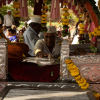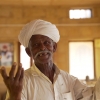Sahapedia: How would you describe your Guru and father Pt. Dinkar Kaikini?
Aditi Kaikini Upadhya: I would like begin by introducing my Guru and father Pt. Dinkar Kaikini to you not as a musician or performer or guru but as a human being. For some of us who had the good fortune of knowing him closely, he was a very simple, honest and forthright person. His keen sense of observation and zest for life made him a man of many interests, which were not confined to music alone. He loved engineering, architecture, painting, cooking, travel, literature, poetry, and took a very keen interest in all of these; he was a true embodiment of creativity and aesthetics. Because of his highly refined sense of aesthetics his approach to life was that of a perfectionist. As a social being, he was a very inclusive and popular person but he valued his solitude just as much. His personality was a paradox of sorts and this made taking taleem (tutelage) from him a very demanding and hard task.
Sahapedia: What was his approach to his Gharana?
Aditi Kaikini Upadhya: His broad minded and inclusive attitude to life was reflected in his outlook to music too. During my years as a student he never isolated or limited himself to a Gharana (in this case Agra Gharana) as such. He always pointed out the salient features and distinct treatment of the Gharana during the taleem of a certain raag but was also open to the different treatment of some raags according to its varied lineage. For example, he sang Raag Savani Bihaag, which is a very popular Jaipur Gharana Raag, in chaste Jaipur style.
His firm belief was that each style or Gharana has its own unique beauty which should be respected, understood and performed accordingly. But he believed in picking up the nuances of other Gharanas as well. So there were several occasions when I was taught a certain raag with all its features from various Gharanas, and taught how to treat each accordingly.
Sahapedia: Could you share some particular memories of his teaching style?
Aditi Kaikini Upadhya: While teaching me, he never pointed out the fact that Agra Gharana was a male dominated Gharana, instead he emphasised how to aesthetically adapt/change what was required to make it my own. My own interpretation of the style was always what he stressed.
He always used to say that no language is harsh; it is the way it is spoken. So always be careful of the way you speak your music. His expectations from all his students were very high, therefore we had to be extremely attentive so we could absorb and imbibe things quickly.
He never believed in simplifying things to fit our understanding. His bar for our taleem was always way higher than our reach, so it gave us many opportunities to stretch ourselves. At the time, there were several instances where we felt that was unreasonable but many years later, I have realised that the musical samskaras (values) that were imparted to us as a result of this, the standards that we absorbed, were of such a high calibre that we never settled for second best or anything less!
There have been so many students who say that the exposure they received through their association with him has made them very keen and refined listeners, if not performers. He always believed that it was as important to make brilliant ‘Kaan-sens’ as it was to groom Tansens — because performers require and depend on discerning audiences in order to grow.
Sahapedia: Could you touch upon his work as a composer?
Aditi Kaikini Upadhya: He was also a great composer and has left behind a big body of work for the next generation in terms of classical composition and he also has to his credit many choral, folk and light music compositions. During his 17 years at All India Radio, Delhi, he composed scores of compositions which had their roots in the pure and traditional form that he was trained in. He always said there is no such thing as classical and light. It is all music. The only thing that differs is the treatment.











